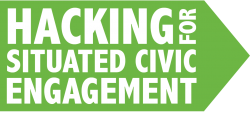
In November, we kicked off Hacking for Situated Civic Engagement, a project funded by EPSRC to explore how hackathons can be used to design civic technologies with communities. Over the course of the project, we’ll be running a series of hackathons with the Ardler community in Dundee to identify and attempt to address some local issues with civic technologies. As the project gets under way, I wanted to explain a bit about the motivations for doing it.
Leaving the Wild
My research has always been about long-term engagement with people to develop technologies that support their local community. In Wray, we worked with a rural community over four or five years to iteratively develop digital noticeboards, while Bespoke used citizen journalism to inspire the design of unique technologies in an area of Preston. The goal is to build cool stuff that responds to particular local needs, and which hopefully has some real and sustainable effect on the community.
But as these projects drew to a close, a recurring theme began to emerge: handing over the technology to the community at the end was pretty difficult. In Wray, we’d always said they could keep the displays at the end, but we hadn’t counted on hardware failures immediately afterwards. Bespoke had likewise planned to hand things over when we finished, but ultimately failed to do so. I wrote a paper about it—Leaving the Wild—suggesting some steps we could take to minimise the difficulties.
Top Down vs Grassroots

More recently, my research has drifted towards civic engagement and activism, aiming to get people more involved in how their communities are run. On Bespoke, we developed Viewpoint, a device that collected feedback from the community by posting questions in public spaces like shops and community centres.
However, while we talked about empowering the community, looking back with a critical eye it’s clear that both the device itself (designed by us) and the questions being asked (by the council and housing organisations), we all operating in a top-down kind of way. I look back and wonder if we could have done more to give citizens a voice, rather than making them passive respondents. PosterVote was partly a response to this, but ultimately it’s usage is still restricted by the form of the device that we designed.
Towards Sustainable Local Innovation
Together, these two problems lead towards an obvious solution: can communities be supporting in building their own stuff?
This is easier said than done, of course. Developing skills and creating a culture of applying these skills to local issues is a big task, and one we don’t intend to solve in its entirety. Rather, this project aims to examine just one piece of the puzzle. We’ll be looking at whether hackathons—intensive bursts of activity around the creation of new technologies—can be used to bring together community members and makers to discuss local issues and propose solutions, while creating enthusiasm around technology and the possibilities it presents. We’ll also be exploring how we can document and share these processes and the things we develop, so that other communities—ones who don’t have a research project working with them—can replicate and take inspiration from the same ideas.
The bulk of the project will take place later in the year, but in the meantime we’ll be attending other people’s hackathons around Scotland and UK to figure out how hackathons are already been appropriated for other purposes. You can keep up with us on the project website, as well as on Twitter.
Leave a Reply